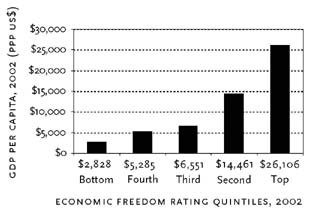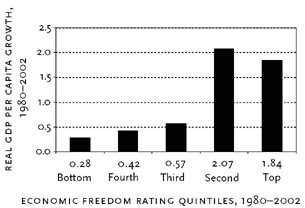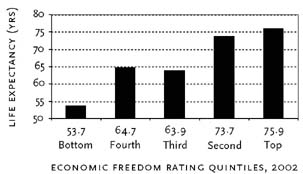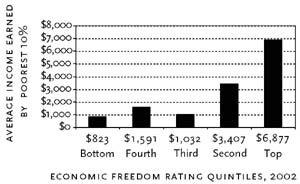Economic Freedom
By Robert A. Lawson

For well over a hundred years, the economic world has been engaged in a great intellectual debate. On one side of this debate have been those philosophers and economists who advocate an economic system based on private property and free markets—or what one might call economic freedom. The key ingredients of economic freedom are personal choice, voluntary exchange, freedom to compete in markets, and protection of person and property. Institutions and policies are consistent with economic freedom when they allow voluntary exchange and protect individuals and their property.
Governments can promote economic freedom by providing a legal structure and a law-enforcement system that protect the property rights of owners and enforce contracts in an evenhanded manner. However, economic freedom also requires governments to refrain from taking people’s property and from interfering with personal choice, voluntary exchange, and the freedom to enter and compete in labor and product markets. When governments substitute taxes, government expenditures, and regulations for personal choice, voluntary exchange, and market coordination, they reduce economic freedom. Restrictions that limit entry into occupations and business activities also reduce economic freedom.
Adam Smith was one of the first economists to argue for a version of economic freedom, and he was followed by a distinguished line of thinkers that includes John Stuart Mill, Ludwig von Mises, Friedrich A. Hayek, and Milton Friedman, as well as economists such as Murray Rothbard.
On the other side of this debate are people hostile to economic freedom who instead argue for an economic system characterized by centralized economic planning and state control of the means of production. Advocates of an expanded role for the state include Jean-Jacques Rousseau and Karl Marx and such twentieth-century advocates as Abba Lerner, John Kenneth Galbraith, Michael Harrington, and Robert Heilbroner. These scholars argue that free markets lead to monopolies, chronic economic crises, income inequality, and increasing degradation of the poor, and that centralized political control of people’s economic lives avoids these problems of the marketplace. They deem economic life simply too important to be left up to the decentralized decisions of individuals.
In the early twentieth century, state control grew as communism and fascism spread. In the United States, the New Deal significantly expanded the role of the state in people’s economic lives. In the late 1970s and early 1980s, economic freedom staged a comeback, with deregulation, privatization, and tax cuts. Of course, the major increase in economic freedom came with the fall of the Soviet Union. Today, the advocates of freedom dominate the debate. In fact, one major socialist, the late Robert Heilbroner, believed that the advocates of freedom have won (see socialism).
Substantial evidence has informed the debate. Indeed, the stark differences in the standards of living of people in economically freer systems compared with those in less-free systems have become more and more obvious: North versus South Korea, East versus West Germany, Estonia versus Finland, and Cubans living in Miami versus Cubans living in Cuba are examples. In each case, people in the freer economy have better lives, in virtually every way, than their counterparts in the less-free economies.
Measuring Economic Freedom
The above comparisons are suggestive. But is it possible to find a relationship between economic freedom and prosperity over a wider range of nations? In the 1980s, scholars began to measure and rate economies based on their degree of economic freedom. Organizations such as Freedom House, the Heritage Foundation, and the Fraser Institute, as well as individual scholars, published “economic freedom indexes” attempting to quantify economic freedom. They came up with an ambitious, and necessarily blunt, measure.
In 1996, the Fraser Institute, along with a network of other think tanks, began publishing the Economic Freedom of the World (EFW) annual reports, which present an economic freedom index for more than 120 nations. Using data from the World Bank, International Monetary Fund, Global Competitiveness Report, International Country Risk Guide, PricewaterhouseCoopers, and others, the report rates countries on a zero-to-ten scale. Higher scores indicate greater economic freedom. The overall index is based on ratings in five broad areas. Counting the various subcomponents, the EFW index uses thirty-eight distinct pieces of data. Each subcomponent is placed on a scale from zero to ten that reflects the range of the underlying data. The component ratings within each area are averaged to derive ratings for each of the five areas. In turn, the summary rating is the average of the five area ratings. The five major areas are:
•Size of government. To get high ratings in this area, governments must tax and spend modestly, and marginal tax rates must be relatively low. While governments are important in protecting property rights, enforcing contracts, and providing some services, as governments grow they inevitably infringe on people’s economic freedom to engage in trade and enjoy the fruits of their labor.
•Sound money. It might not be clear at first why this is a measure of freedom rather than just a measure of good economic policy. But money would likely be sound if the government did not have a legal monopoly over the money supply (see competing money supplies and gold standard). Therefore sound money is a measure of how much the government refrains from abusing its monopoly power. To get high ratings here, a country’s inflation must be low and stable, and the government must permit people to own currencies of other nations.
•Property rights and rule of law. This area measures the consistency of a country’s legal system with the protection of property, enforcement of contracts, and evenhanded application of the law. This is perhaps the most important area of economic freedom, as economic freedom requires that people be secure in their persons and physical property; it also requires a judicial system that enforces contractual agreements fairly.
•International trade. Countries that refrain from enacting protectionist tariffs, quotas, and capital controls get higher ratings in this area (see international trade). Economic freedom means that people can engage in trade with any person of their choosing. If the government taxes or otherwise prevents people from buying or selling with people in other countries, it reduces their freedom.
•Regulation. Regulations such as interest-rate controls (usury laws), restrictions on bank ownership by foreigners, minimum wages, military conscription, business licensing, and price controls are included. Such controls and regulations violate the principles of economic freedom. To get high ratings, countries must refrain from such regulations, leaving people free to set prices, open businesses, and trade.
Any attempt to measure freedom on this basis inevitably omits the details. Because all these factors are weighted equally, two countries could have identical indexes in different ways: one might have high taxes but a good rule of law, while another may have low taxes but a poor legal system. An economic freedom index allows us to make broad comparisons among countries, but the index is a blunt measure.
What is the freest economy in the world? Hong Kong. Hong Kong has relatively low taxes, a good legal system, sound money, free trade, and minimal regulations; and it has had these institutions and policies in place for several decades. Other highly rated countries include Singapore, the United States, New Zealand, and the United Kingdom. Table 1 shows the economic freedom ratings of selected countries for 1980, 1990, and 2002.1
Singapore is an interesting case because it exhibits an odd combination of high economic freedom and considerable political and civil repression. Although economic freedom and political freedom tend to go together, especially in the long run, Singapore is an exception. It will be worth watching to see if Singapore can maintain this situation. Many scholars believe that economic freedom and political repression are an unsustainable combination.2
Some countries, such as Hong Kong, Singapore, and the United States, consistently registered high ratings throughout the 1980s and 1990s. Germany’s economic freedom rating has also been quite steady. Germany’s rating in 2002 was 7.3, compared with 7.0 in 1980. Because several other countries have made substantial improvements, however, Germany’s ranking has declined, receding to twenty-second in 2002 from fifth in 1980. Likewise, because other countries have improved, France’s ranking fell to forty-fourth from twenty-eighth in 1980.
Looking at some absolute scores, one can note a clear trend worldwide toward economic liberalization since 1980. The highest-rated African nation, Botswana, increased its rating from 5.0 in 1980 to 7.4 in 2002 and now ranks eighteenth in the world. Also in Africa, Mauritius’s rating jumped from 4.7 in 1980 to 6.1 in 1990 and 7.2 in 2002. In Latin America, Chile’s rating improved from 5.3 in 1980 to 7.3 in 2002, making it the highest-rated country in its region.
Among developed countries we also have seen some big reformers. Ireland’s rating jumped from 6.2 in 1980 to 7.8 in 2002. The United Kingdom was a big gainer during the Thatcher years, when its rating rose from 6.1 in 1980 to 7.7 in 1990 and, ultimately, to 8.2. Similarly, New Zealand’s economic reforms in the late 1980s and early 1990s caused its rating to increase from 6.1 in 1980 to 8.2 in 2002. While these gains are not the largest seen in the world, they do show that well-established developed economies can implement significant economic liberalization.
The world’s two largest economies by population, India and China, both have low ratings. But both have made tremendous strides toward more economic freedom. China’s rating increased from 3.8 to 5.7, and India’s rose from 4.9 to 6.3. While their current ratings are still low by world standards, these improvements in economic freedom have been quite substantial; both countries’ economies are growing rapidly as a result.
|
|
|||||
| Economic Freedom Rating | |||||
| 2002 Ranking | Country | 2002 | 1990 | 1980 | |
| 1 | Hong Kong | 8.7 | 8.6 | 8.6 | |
| 2 | Singapore | 8.6 | 8.5 | 7.5 | |
| 3 | New Zealand | 8.2 | 7.3 | 6.1 | |
| 3 | United Kingdom | 8.2 | 7.7 | 6.1 | |
| 3 | United States | 8.2 | 8.1 | 7.4 | |
| 9 | Ireland | 7.8 | 7.0 | 6.2 | |
| 11 | Estonia | 7.7 | |||
| 14 | Iceland | 7.6 | 6.6 | 4.9 | |
| 18 | Botswana | 7.4 | 5.4 | 5.0 | |
| 22 | Chile | 7.3 | 6.8 | 5.3 | |
| 22 | Germany | 7.3 | 7.3 | 7.0 | |
| 27 | Mauritius | 7.2 | 6.1 | 4.7 | |
| 44 | France | 6.8 | 6.8 | 5.7 | |
| 58 | Mexico | 6.5 | 5.7 | 5.1 | |
| 68 | India | 6.3 | 4.8 | 4.9 | |
| 86 | Argentina | 5.8 | 4.4 | 3.9 | |
| 86 | Indonesia | 5.8 | 6.6 | 5.2 | |
| 90 | China | 5.7 | 4.2 | 3.8 | |
| 103 | Romania | 5.4 | 4.0 | ||
| 114 | Russia | 5.0 | |||
| 118 | Venezuela | 4.6 | 5.6 | 6.7 | |
| 122 | Zimbabwe | 3.4 | 4.9 | 4.7 | |
|
|
|||||
| Source: Economic Freedom of the World: 2004 Annual Report, table 1.4 | |||||
Among the former Soviet and centrally planned economies, some have succeeded greatly in increasing economic freedom. Estonia now ranks thirteenth in the world, having instituted nearly complete free trade, a stable monetary policy, and considerable fiscal restraint. In 1995, it was ranked eighty-first. Meanwhile, some of these nations have shown little progress; Russia and Romania, for instance, rank near the bottom of the list and show few signs of improvement. In these countries, the near inability of the legal system to protect property and fairly enforce contracts—and the corruption this inevitably ensures—is a particularly big problem from the standpoint of both economic freedom and economic growth.
Only a few countries have moved away from economic freedom in the last twenty years. Zimbabwe has recently taken a turn for the worse as the government continues to attack property rights and impose tight controls on economic activity. Venezuela has steadily declined in its rating (and ranking). In the early 1970s, Venezuela ranked in the top twenty, but by 2002 it had fallen to the very bottom.
Economic Freedom and Economic Results
An economic freedom index allows researchers to examine the empirical relationships between economic freedom and other desirable social outcomes. The big question is: Do countries that exhibit greater degrees of economic freedom perform better than those that do not?
Much scholarly research has been and continues to be done to see if the index correlates with various measures of the good society: higher incomes, economic growth, income equality, gender equality, life expectancy, and so on. While there is scholarly debate about the exact nature of these relationships, the results are uniform: measures of economic freedom relate positively with these factors.
The figures that follow illustrate the simple relationship between the economic freedom index and various measures of economic and social progress. These figures indicate the relationships that more scholarly studies have found, but they are not conclusive evidence. Economic growth, for example, appears to be related to both the level of economic freedom and changes in the level of economic freedom as well as to investment in physical and human capital. The simple graphs on the next page are no substitute for more scholarly work.3 Nevertheless, these simple relationships are a starting point for examining the links between economic freedom and economic results.
Figure 1 shows the economic freedom ratings related to GDP per capita. The chart organizes the world into five quintiles ordered from the countries with the least economic freedom to the countries with the most. As economic freedom increases, so does average income.
The level of economic development at any point in time is, of course, the result of the accumulation of capital and technology over a long period. Figure 2 illustrates the correlation between economic growth (rates of change in GDP per capita) between 1980 and 2002 and the average level of the economic freedom index since 1980. Figure 3 illustrates the large improvements in life span associated with greater economic freedom.
While there is no clear evidence that economic freedom creates greater income inequality, there is clear evidence that lowest-income people in freer countries are better off than their counterparts in less free countries. Figure 4 shows the average income level of the poorest tenth of the population by economic freedom quintile. Clearly, as Adam Smith recognized more than 230 years ago, economic freedom and the economic prosperity it brings work to the advantage of the poor.
As time goes on, these measures of economic freedom will improve and our understanding of the relationship between private property and free markets and economic performance will similarly improve. But in the great debate between economic freedom and political planning, the evidence is increasingly clear. Economic freedom leads to better economic results.
Further Reading
Footnotes




